#survival of species
Text
Nature is not cruel, only pitilessly indifferent.
Richard Dawkins
Every morning in Africa, a gazelle wakes up, it knows it must outrun the fastest cheetah or it will be killed. Every morning in Africa, a cheetah wakes up. It knows it must run faster than the slowest gazelle, or it will starve. It doesn’t matter whether you’re the cheetah or a gazelle – when the sun comes up, you better be running.
#dawkins#richard dawkins#quote#cheetah#gazelle#survival#nature#jungle#darwinian#survival of species#africa#speed
188 notes
·
View notes
Photo

(via Captive-born Mexican gray wolf is killed in New Mexico)
A Mexican gray wolf that conservation advocates say was genetically significant to the species' recovery in the wild has been found dead in New Mexico.
The U.S Fish and Wildlife Service confirmed the death of the captive-bred and released Mexican gray wolf known as No.1693. The wolf was discovered on Oct. 8. Fish and Wildlife officials have not released details on his killing because it is still under investigation by law enforcement.
The death came just days after the Fish and Wildlife agency announced a revision to the Mexican gray wolf recovery plan with proposed actions to reduce human-caused wolf mortality.
Mexican wolf No. 1693 was released into the wild in 2018 when he was just 15 days old. He was cross-fostered into a wild wolf den in an effort to increase the genetic diversity of the wild population of wolves, a step biologists say is critical to the survival of the species.
more idiots killing critically important wildlife
#Mexican gray wolf#genetically significant#survival of species#killed#under investigation by law enforcement
24 notes
·
View notes
Text


the fritter (frin critter)
#inspo struck right after posting the last two. some kind of a hermit crab. a snail#they think they look all cool and mysterious under their safety shelter but if u remove it they're a disastrous puffball of uncombed fur#the hat is not accurate to an adult human btw. i tried to put them in a full size hat and they were lost forever. this is a child sized hat#they need to swap out for bigger hats as they grow#MY FRIENDS WROTE AND DREW SO MUCH FOR THE FRITTER I HOPE THEY CAN REBLOG AND ADD BC THEYRE SO GOOD <3#we started making a whole au about critter species in the wild and how they interact and survive. very fascinating.#i need to collect all the worldbuilding into one place eventually. rn all i'll say is.. overworked odile petsmart employee (tealgoat's idea#isat#in stars and time#isat siffrin#my art#a6se/twohats (this tag only) implication then is that loop is bald i guess aksdks. loop = wild shorthair. fritter = domestic longhair.
2K notes
·
View notes
Text
At some point in your life, there will be a moment where exactly - or near exactly - half the people in the world are younger than you, and half the people are older.
And I think that moment should be the one your soulmate Mark appears at, not at birth or puberty or something. Both because at birth is kind of boring but it's also very you-centric and soulmates are about the thing outside of you being a part of you, and I think it would be nice to include The World.
But also I think it would have fascinating implications for scientific and social studies. Longevity trends tracked by the average age soul marks appear. Tragedies causing a rash of recent marks to disappear (because the people are no longer the middle). Marks appearing early during baby booms.
#soulmates#i just think it would be neat#and let people survive their teenage years#and discover who they are before they get told who they're matched with#gives everyone a chance to fall in love naturally#AND best of all#it means YOUR mark may appear now but if your soul mate is younger than you#it wouldn't appear for them yet#meaning a new dynamic and honestly less stress i think#because if you fall in love with someone not your soulmate you wouldn't necessarily know#unless you were the exact same age somehow#which tbh since soulmates isn't romantic a large portion of the time#twins probably share a mark#in this world you can have as many soulmates as you want btw#you can have pets be soulmates too but their mark appears when#they're the middle point for their species#i should really sleep#nightblogging
491 notes
·
View notes
Text
Humans are so cute. They think they can outsmart birds. They place nasty metal spikes on rooftops and ledges to prevent birds from nesting there.
It’s a classic human trick known in urban design as “evil architecture”: designing a place in a way that’s meant to deter others. Think of the city benches you see segmented by bars to stop homeless people sleeping there.
But birds are genius rebels. Not only are they undeterred by evil architecture, they actually use it to their advantage, according to a new Dutch study published in the journal Deinsea.
Crows and magpies, it turns out, are learning to rip strips of anti-bird spikes off of buildings and use them to build their nests. It’s an incredible addition to the growing body of evidence about the intelligence of birds, so wrongly maligned as stupid that “bird-brained” is still commonly used as an insult...
Magpies also use anti-bird spikes for their nests. In 2021, a hospital patient in Antwerp, Belgium, looked out the window and noticed a huge magpie’s nest in a tree in the courtyard. Biologist Auke-Florian Hiemstra of Leiden-based Naturalis Biodiversity Center, one of the study’s authors, went to collect the nest and found that it was made out of 50 meters of anti-bird strips, containing no fewer than 1,500 metal spikes.
Hiemstra describes the magpie nest as “an impregnable fortress.”
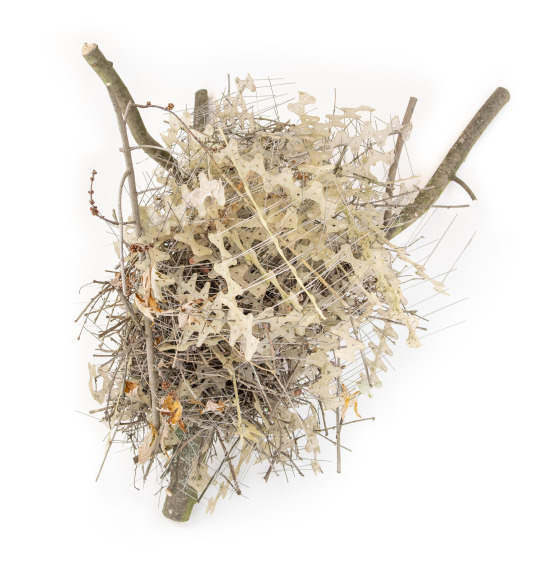
Pictured: A huge magpie nest made out of 1,500 metal spikes.
Magpies are known to build roofs over their nests to prevent other birds from stealing their eggs and young. Usually, they scrounge around in nature for thorny plants or spiky branches to form the roof. But city birds don’t need to search for the perfect branch — they can just use the anti-bird spikes that humans have so kindly put at their disposal.
“The magpies appear to be using the pins exactly the same way we do: to keep other birds away from their nest,” Hiemstra said.
Another urban magpie nest, this one from Scotland, really shows off the roof-building tactic:

Pictured: A nest from Scotland shows how urban magpies are using anti-bird spikes to construct a roof meant to protect their young and eggs from predators.
Birds had already been spotted using upward-pointing anti-bird spikes as foundations for nests. In 2016, the so-called Parkdale Pigeon became Twitter-famous for refusing to give up when humans removed her first nest and installed spikes on her chosen nesting site, the top of an LCD monitor on a subway platform in Melbourne. The avian architect rebelled and built an even better home there, using the spikes as a foundation to hold her nest more securely in place.
...Hiemstra’s study is the first to show that birds, adapting to city life, are learning to seek out and use our anti-bird spikes as their nesting material. Pretty badass, right?
The genius of birds — and other animals we underestimate
It’s a well-established fact that many bird species are highly intelligent. Members of the corvid family, which includes crows and magpies, are especially renowned for their smarts. Crows can solve complex puzzles, while magpies can pass the “mirror test” — the classic test that scientists use to determine if a species is self-aware.
Studies show that some birds have evolved cognitive skills similar to our own: They have amazing memories, remembering for months the thousands of different hiding places where they’ve stashed seeds, and they use their own experiences to predict the behavior of other birds, suggesting they’ve got some theory of mind.
And, as author Jennifer Ackerman details in The Genius of Birds, birds are brilliant at using tools. Black palm cockatoos use twigs as drumsticks, tapping out a beat on a tree trunk to get a female’s attention. Jays use sticks as spears to attack other birds...
Birds have also been known to use human tools to their advantage. When carrion crows want to crack a walnut, for example, they position the nut on a busy road, wait for a passing car to crush the shell, then swoop down to collect the nut and eat it. This behavior has been recorded several times in Japanese crows.
But what’s unique about Hiemstra’s study is that it shows birds using human tools, specifically designed to thwart birds’ plans, in order to thwart our plans instead. We humans try to keep birds away with spikes, and the birds — ingenious rebels that they are — retort: Thanks, humans!
-via Vox, July 26, 2023
#birds are literally learning how to better live/survive alongside us#this is like. actually kind of remarkable. and the technique is spreading including to other species.#is this hopepunk? it kinda feels like hopepunk to me.#animals are literally learning how to use our attempts to get rid of them against us#that's kind of amazing#and also VERY encouraging re: life's innate resilience#crows#magpie#corvid#crow#bird#bird nest#bird nerd#bird news#adaptation#urban animals#ornithology#climate adaptation#kinda#good news#hope#hope posting#hopepunk#animal intelligence#wildlife#animals are awesome
1K notes
·
View notes
Text


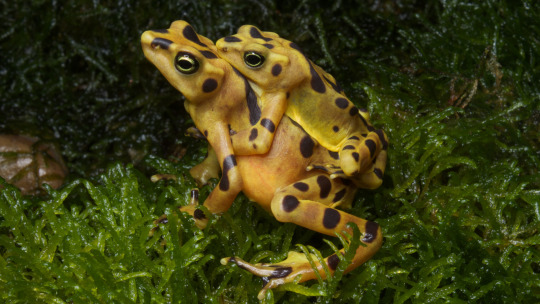
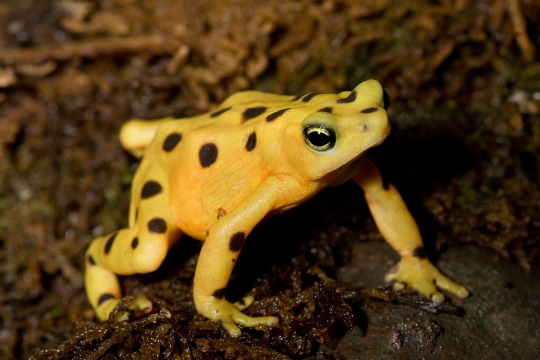
Panamanian Golden Frog
Atelopus zeteki
These guys are tiny. So small, in fact, that they’re born without eardrums. They use a form of sign language called semaphore to communicate with other frogs. This sign language involves waving hands and raising feet to greet each other, defend territory, or attract a mate. For example, male frogs will wave their arms to attract females, and females will wave back if they are interested.
Unfortunately, they’ve been extinct in the wild since 2007 due to the amphibian chytrid fungus but they’re being bred successfully in captivity.
#panamanian golden frog#atelopus zeteki#frogposting#frog#toad#panama#sign language#amphibians#amphiblr#amphibian#frogblr#toadblr#mine#biology#zoology#marine animals#marine biology#extinct species#animals#science#rainforest#SSP#species survival plan#herpetology#herpetologist
259 notes
·
View notes
Text
anybody else ever think about how knuckles and shadow are both the last of their kind but how they ended up in that situation and their feelings surrounding it are completely different. idk i just think its interesting
#knuckles just being born into that situation and shadow wiping out the rest of his species himself .............................#and by shadow being the last of his kind i mean that hes the last surviving member of the black arms#not that hes the last hedgehog. obviously hes not the last hedgehog . sonic and amy and silver are right there#before anyone goes ''Ummm black doom is alive actually havent you seen the sxs generations trailer/description''#hes probably there through time travel shenanigans since shadow's part of the story still takes place during generations#so im just gonna assume that hes still dead. unless the game comes out and shows that he isnt
242 notes
·
View notes
Text

#itsjustoneofthosedayswhenyoudontwannawakeup#my re au i'm NOT telling anyone about ever#he's bound cause his species can only survive in captivity#resident evil#albert wesker#my art#hdi#everythingisfuckedeverybodysucks
261 notes
·
View notes
Text
do you guys ever think abt v1 getting stained more and more with blood as they go thru hell and ending up looking like v2. like ik that not how it work but man even in death theyre still there yknow. like how v1 keeps v2 alive technically thru their arms.
#always found it interesting that often i cant tell which is which in v4v art unless its coloured#even so with the blood on v1 often its hard to tell as well#perhaps during the v2 battles v1 ends up looking exactly like v2 basically#especially with the knuckleblaster#this also makes me think about how in fanart a lot of the times#especially for v4v but this applies to basically any ship fanart#its always just a mess of tangled limbs and metal#you cant separate one from another#thats the connection between violence and romance here i think#‘o mah gahh my shape language and clear silouhettes’#sometimes happy mistakes happen and become glorious#like how genetic mutations lead to an overall stronger species with a high survival rate#you can tell im running on 6 hrs of sleep#ultrakill#v4v#i still love v4v#i think im just a sucker for hatefucking intrinsically entertwined enemies that feel no technical attraction to each other#its because i cant feel romantic attraction well thats why 😂
74 notes
·
View notes
Note
bug trolls… i am interested in kankri vantas. if that isn’t too much trouble. your buggy guys are so silly and interesting and i am a fan
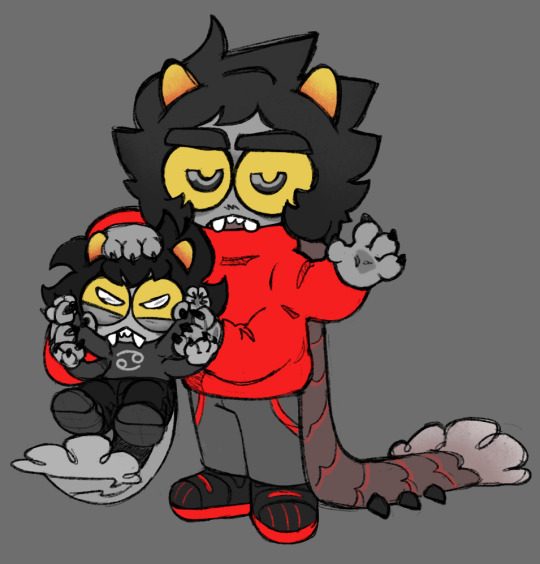
here is kankri and his baby brother…. they don’t get along!! i wish they did though id love to see these two go on an adventure together where they look out each other. since kankri is a beforus troll and a vegan, his shell is pretty thin because he’s not getting enough iron. on the other hand, karkat’s shell is heavier then it should be due to stress.
thanks for the RQ!! im soooo glad ppl like my sillies :D
#kankris picking up karkat because karkat said fuck you im going to come over there and cram my scythe down your ignorance shaft#kankri said no you arnt. you’re not going to do that. im not letting you do that.#karkat vantas#kankri vantas#homestuck#trolls#buggy trolls#want to see these 2 depending on each other to survive in alternia. i think it would be very hard for them to do#but i think they could grow and develop in interesting ways if they got to be brothers who fight#enrichment in the isopod tank#redbloods#these two are natural drama that’s engaging story!! ive never really read a fic i liked that rlly got into their companionship as brothers#like there’s quite a few abt dirk and dave as brothers#most fics that have both of them focus more on their bonds with the sufferer#if anyone has a recommendation I’d love to hear it#give them crabdad no sufferer make them struggle in this cruel world. highly protective kankri grumpy wrathful karkat#they can’t stand each other but also rely on each other. redblood moment#given that isopods are comparatively social and good natured to many of the other troll buggy species I’ve picked out#that’s what I’m SAYIN#^silly#ok bye
198 notes
·
View notes
Text
Endangered Indian sandalwood. British war to control the forests. Tallying every single tree in the kingdom. European companies claim the ecosystem. Spices and fragrances. Failure of the plantation. Until the twentieth century, the Empire couldn't figure out how to cultivate sandalwood because they didn't understand that the plant is actually a partial root parasite. French perfumes and the creation of "the Sandalwood City".
---
Selling at about $147,000 per metric ton, the aromatic heartwood of Indian sandalwood (S. album) is arguably [among] the most expensive wood in the world. Globally, 90 per cent of the world’s S. album comes from India [...]. And within India, around 70 per cent of S. album comes from the state of Karnataka [...] [and] the erstwhile Kingdom of Mysore. [...] [T]he species came to the brink of extinction. [...] [O]verexploitation led to the sandal tree's critical endangerment in 1974. [...]
---
Francis Buchanan’s 1807 A Journey from Madras through the Countries of Mysore, Canara and Malabar is one of the few European sources to offer insight into pre-colonial forest utilisation in the region. [...] Buchanan records [...] [the] tradition of only harvesting sandalwood once every dozen years may have been an effective local pre-colonial conservation measure. [...] Starting in 1786, Tipu Sultan [ruler of Mysore] stopped trading pepper, sandalwood and cardamom with the British. As a result, trade prospects for the company [East India Company] were looking so bleak that by November 1788, Lord Cornwallis suggested abandoning Tellicherry on the Malabar Coast and reducing Bombay’s status from a presidency to a factory. [...] One way to understand these wars is [...] [that] [t]hey were about economic conquest as much as any other kind of expansion, and sandalwood was one of Mysore’s most prized commodities. In 1799, at the Battle of Srirangapatna, Tipu Sultan was defeated. The kingdom of Mysore became a princely state within British India [...]. [T]he East India Company also immediately started paying the [new rulers] for the right to trade sandalwood.
British control over South Asia’s natural resources was reaching its peak and a sophisticated new imperial forest administration was being developed that sought to solidify state control of the sandalwood trade. In 1864, the extraction and disposal of sandalwood came under the jurisdiction of the Forest Department. [...] Colonial anxiety to maximise profits from sandalwood meant that a government agency was established specifically to oversee the sandalwood trade [...] and so began the government sandalwood depot or koti system. [...]
From the 1860s the [British] government briefly experimented with a survey tallying every sandal tree standing in Mysore [...].
Instead, an intricate system of classification was developed in an effort to maximise profits. By 1898, an 18-tiered sandalwood classification system was instituted, up from a 10-tier system a decade earlier; it seems this led to much confusion and was eventually reduced back to 12 tiers [...].
---
Meanwhile, private European companies also made significant inroads into Mysore territory at this time. By convincing the government to classify forests as ‘wastelands’, and arguing that Europeans would improves these tracts from their ‘semi-savage state’, starting in the 1860s vast areas were taken from local inhabitants and converted into private plantations for the ‘production of cardamom, pepper, coffee and sandalwood’.
---
Yet attempts to cultivate sandalwood on both forest department and privately owned plantations proved to be a dismal failure. There were [...] major problems facing sandalwood supply in the period before the twentieth century besides overexploitation and European monopoly. [...] Before the first quarter of the twentieth century European foresters simply could not figure out how to grow sandalwood trees effectively.
The main reason for this is that sandal is what is now known as a semi-parasite or root parasite; besides a main taproot that absorbs nutrients from the earth, the sandal tree grows parasitical roots (or haustoria) that derive sustenance from neighbouring brush and trees. [...] Dietrich Brandis, the man often regaled as the father of Indian forestry, reported being unaware of the [sole significant English-language scientific paper on sandalwood root parasitism] when he worked at Kew Gardens in London on South Asian ‘forest flora’ in 1872–73. Thus it was not until 1902 that the issue started to receive attention in the scientific community, when C.A. Barber, a government botanist in Madras [...] himself pointed out, 'no one seems to be at all sure whether the sandalwood is or is not a true parasite'.
Well into the early decades of twentieth century, silviculture of sandal proved a complete failure. The problem was the typical monoculture approach of tree farming in which all other species were removed and so the tree could not survive. [...]
The long wait time until maturity of the tree must also be considered. Only sandal heartwood and roots develop fragrance, and trees only begin developing fragrance in significant quantities after about thirty years. Not only did traders, who were typically just sailing through, not have the botanical know-how to replant the tree, but they almost certainly would not be there to see a return on their investments if they did. [...]
---
The main problem facing the sustainable harvest and continued survival of sandalwood in India [...] came from the advent of the sandalwood oil industry at the beginning of the twentieth century. During World War I, vast amounts of sandal were stockpiled in Mysore because perfumeries in France had stopped production and it had become illegal to export to German perfumeries. In 1915, a Government Sandalwood Oil Factory was built in Mysore. In 1917, it began distilling. [...] [S]andalwood production now ramped up immensely. It was at this time that Mysore came to be known as ‘the Sandalwood City’.
---
Text above by: Ezra Rashkow. "Perfumed the axe that laid it low: The endangerment of sandalwood in southern India." Indian Economic and Social History Review 51, no. 1, pages 41-70. March 2014. [Bold emphasis and some paragraph breaks/contractions added by me. Italicized first paragraph/heading in this post added by me. Presented here for commentary, teaching, criticism purposes.]
#a lot more in full article specifically about#postindependence indian nationstates industrial extraction continues trend established by british imperial forestry management#and ALSO good stuff looking at infamous local extinctions of other endemic species of sandalwood in south pacific#that compares and contrasts why sandalwood survived in india while going extinct in south pacific almost immediately after european conques#abolition#ecology#imperial#colonial#landscape#indigenous#multispecies#tiger#tidalectics#archipelagic thinking#intimacies of four continents#carceral geography#geographic imaginaries#haunted
220 notes
·
View notes
Text
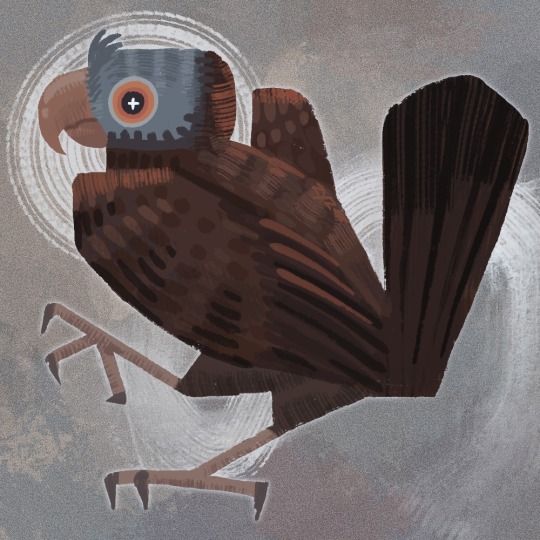
Day 19 of extinct birds - the broad-billed parrot (note that we don't actually know what colour they are, this depiction is only my guess!)
This was another bird from the Mascarene islands. With only short accounts, a few bones and a single sketch to go by, we know almost nothing about them. They were called 'indian crows', which could imply dark colours and/or harsh calls. The only notes on their colour are that they were red with blue heads - one sailor noted they were 'beautifully coloured' but we might never get to know them.
#psittaciformes#Only a single parrot species on the island group survived#which is just#devastating#but it shows the impact of protected parks#and im glad we still get to remember the extinct birds in some form#bird of the day#bird art#extinct animals#birds#digital illustration#bird#ornithology#daily art#digital art
233 notes
·
View notes
Text

zazie
#trigun#zazie#zazie the beast#taps mic anyone here cares abt zazie. is it crickets.#i’ve been sooo interested in zazie and their lore/significance to the story since reading trimax#i feel like adding another variable to the conflict would have been rly interesting and that variable being the native species#on no mans land would have added more nuance to the story#and there was an attempt to discuss that but nothing rly came of it#cause of THE MENACE OF SOCIETY escaping his damn ward cell#i want more worm involvement#in a story so heavily focused on the survivability of one’s species and abuse of power i just think. looking more in depth at the hosts#of the planet would have been cool.#guy in chair rocking back and forth manically#and i love bugs also#cupidle
693 notes
·
View notes
Text
Immune
When a horde of Zombies was unleashed on the DC universe, Danny stared at the screen speechless. Clockwork had told him to keep an eye on the universe in case a catastrophe happened, but only 5 minutes had passed since then.
He called his mentor and the Master of Time told him to fix the problem, to which Danny began to complain before being pushed straight into a dimensional portal. He landed in the middle of a fucking horde, just his luck.
How was he going to prevent a fucking apocalypse? It had already started!
As he used his intangibility to get past the Zombies, he noticed the confused look most of them were sending him, but oh well. Danny was tempted to tell them that you can't kill what was dead, but he decided to keep quiet. Not that the Zombies understood anyway.
He set out to explore the world looking for some clues, avoiding the Zombies (For some reason, they avoided him too) and drawing the attention of the resistance, who quickly branded him as immune (he wasn't, he had just become intangible, again).
Ironically, he ended up siding with the only Zombie? Of a different race. Red Hood was much nicer than those who wanted a sample of his blood for a cure (again, Danny knew it wasn't going to work). But neither of them had any idea how to end the apocalypse.
Jason had no idea why the Zombies were avoiding that specific boy, like he was a hopeless case. Or why there were so many people chasing him, but at least he was nice, and seemed genuinely intent on 'stopping the apocalypse', so he joined him out of curiosity.
He was like a free Zombie repellant anyway, and Jason had no idea where his family was since the catastrophe started.
#dpxdc#Danny in the apocalypse#Clockwork pushed him into a zombie hoard#He knew the halfa was going to survive#After some time the zombies started avoiding him#Like he was some kind of zombie repellant#Zombies knew Danny was a hopeless case#Jason is kinda immune too#Zombies just attack him out of rage#like two differents species hating each other#dp x dc#dc x dp#The survivors tough Danny was immune#And started chasing him#Danny doesn't want to offer his blood samples#He is now traveling with Jason#searching for a cure#or a way to stop the zombiefication#while avoiding the survivors#and being avoided by the zombies#Jason like him#Jason doesn't know where his family is#is hard to explore Gotham without the repellant boy because the zombies always attack him
496 notes
·
View notes
Text
Prompt 108
So this time it wasn’t Danny’s fault, or even Boxy’s fault! And it wasn’t like Pandora’s box was open for more than a split second! But uh, still. This could be a bit of a problem, what with how it’s affected um, well, everyone. Living and ghosts.
At least it’s not dangerous! Really, how bad can people getting animal aspects be? Well, besides the embarrassment.
#dcxdp#dpxdc#prompts#Over in Gotham Catwoman is squealing with elation at her new cat ears and tail#Superman is bemused at being part dog now- his tail won’t stop wagging help#Jason is thinking this is some sort of sick joke when he scarlet robin wings#the claws are kind of cool though he’ll admit#Pet adoption centers get a lot of visitors thanks to people no longer being allergic to animals they previously were#Several people want to go back to sleep#other people want to know wtf is going on#danny definitely didn't do an oopsie#Tucker looking at himself: If I am a sphinx now I will be blaming you if Riddler or catwoman kidnaps me dude#Sam: At least aricaris can survive on my diet so I'm good#Danny & Tucker: How did you figure out the species so quickly????#WHEEZE- box ghost is part box turtle now
258 notes
·
View notes
Text
I don't even eat meat that often but the moment a vegan tries to preach to me I become the biggest meat fan ever. Mmmm you're just jealous of my Yummy Burger oooohhh
#I refuse to believe that something thousands of species on this planet do and need to do to survive is morally bankrupt sorry#Chimken nugget#ruby speaks
39 notes
·
View notes